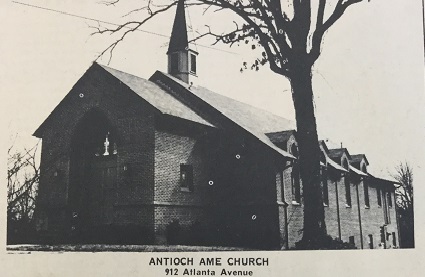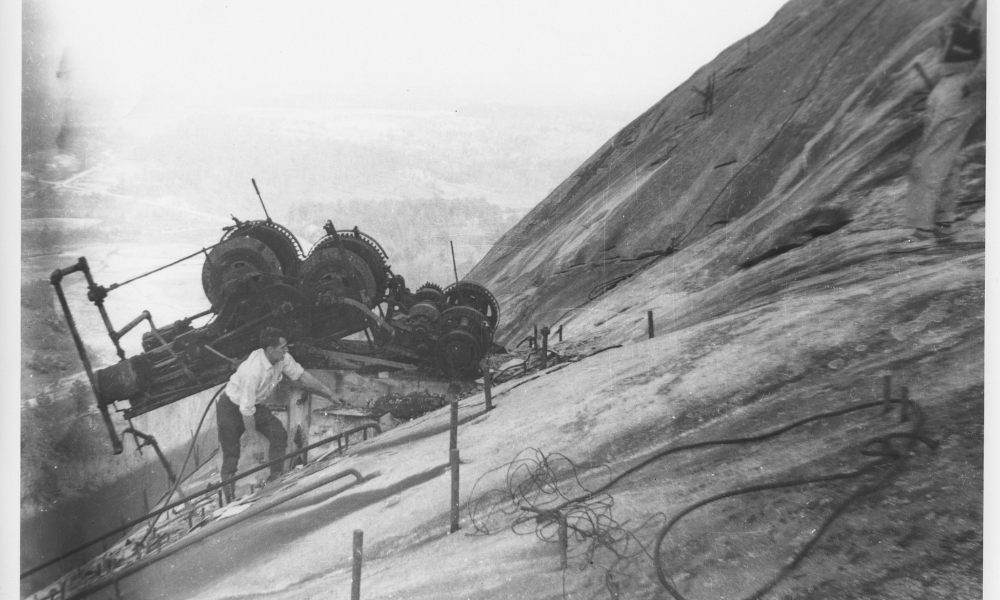Historic Antioch AME Church, Decatur
Antioch AME Church
Before the Civil War, many slaves had belonged to their owners’ church where they were taught scripture and baptized. After the war, encouraged by their newfound independence, the newly freed slaves began constructing their own places of worship. Founded in 1868 during the Reconstruction period, Antioch African Methodist Episcopal Church became among the first African-American churches in DeKalb County. In time of uncertainty and adjustment during the aftermath of the Civil War, many African-American churches provided a sense of community among the newly freed slaves. Antioch served as center for this community in DeKalb County, holding many conventions and putting on social and political events during its history.
Derived from Acts 11:26 in the Bible, the name “Antioch” refers to the city in which Paul’s disciples were first called Christians. The church started in the home of Sister Lou Bratcher on what became known as Electric Avenue with newly freed slaves and free blacks comprising the congregation. The congregation gathered every first and third Sunday of the month for worship services. The meetings led by the ministers of the church were Jethro Brooks, Henry Anderson, William Howard, Van Ross, and James Jackson.

Antioch AME Church located on Atlanta Avenue (Hibernia). The sanctuary was torn down in 2014.
The church did not have a dedicated building to worship in at the time, and when the weather became too hot, the congregation worshiped outside under the cover of bush arbors. Eventually the congregation grew out of Sister Bratcher’s home and Brother Jethro Brooks donated land to build a church. In 1874, the congregation built a one-room structure on Marshall Street (near where the Calloway building stood until recently demolished on Trinity Street in Decatur) at this location Rev. Joseph Woods conducted services with Rev. William Stencil. By that time, the congregation had grown tremendously from its beginnings in 1868. The church began distributing tickets for members to get seats or a spot at the communion table during services.
Since 1868, Antioch served as the home for multiple preachers in DeKalb County with the church hosting approximately 49 pastors by 1971. In its beginning, Antioch acted as a “circuit rider”– meaning preachers who served around the area would come and preach at Antioch for a few years. The practice would continue until the appointment of Rev. D.W. Wiggs to the pastorate in the 1930s. The first of these itinerant preachers was residential pastor, Rev. Pierce. The wife of Rev. Pierce, known for her musical ability, organized the first choir at the church. The first stewardess board formed under Rev. Pierce, composed of the following members: Lucille Powell, Louise Bratcher, Leona McNeil, Sallie Duraham, Cora Griffin, Hortena Barnett, Georgia Chronie, and Julia Espey.
Rev. Zeigler became the next pastor in Antioch’s history, during his tenure the church purchased their church bell and the church’s first organ around 1889. The mothers of the church raised funds to buy the church’s first organ. A contest between Rev. Zeigler, George Griffin, and others helped raise the money to purchase the church bell. The bell hung in the belfry of the church until the construction of the second church building in the 1930s where the bell did not fit in the church’s small bell tower. After the church moved to Stone Mountain in the 1990s, the bell would be stolen in March 2010 from where the bell had rested behind the church awaiting a new steeple to hold it.
After Zeigler, Antioch hosted a series of pastors: Rev. Gibson, Hibbs, Brockett, Robinson, Haggler, Bowdeny, Harper, King, Chappell, Flaggs, Lee, H.D. Canady, Rev. Bellsaw, Rev. Byrd, and Rev. Joe Woods. Appointed in the 1930s, D.W. Wiggs marked the end of itinerant preachers at Antioch. Rev. D.W. Wiggs helped reorganize the church and lay the plans for a new church building. In 1933, a brick structure on Marshall Street and Cooper Street replaced the original one room church despite the effects of the Great Depression.
The next biggest change to the church came in the 1960s under Rev. T.J. Flanagan. Bishop W.R. Wilkes asked Dr. Thomas Jefferson Flanagan to take on the pastorate in response to the federal urban renewal program in the 1960s. Dr. Flanagan’s first action as pastor was to relocate the church. Finding land proved to be extremely difficult, but eventually Flanagan found a vacant lot on Atlanta Avenue. Antioch purchased the land, which had served to divide the black and white sections of Decatur, for $28,000. The church broke ground on the new land in January 1965 and started work in April 1965. In October 1965, the congregation moved into their new home on 912 Atlanta Ave. in downtown Decatur. The church later added a tower to house the church bell so that it could ring for the U.S. bicentennial in 1976.
As Decatur grew in the 1990s, the housing authorities closed off Atlanta Avenue gravely affected by MARTA being routed into downtown Decatur in lieu of running along the railroad track and sold the land to developers. The developers began building townhouses and single-family homes ranging from $115,000 to $130,000. With the rising cost of living in the area displacing several members and with no direct access to the church, Antioch’s membership began to diminish.
In 1995, Antioch relocated to South Hairston Road in Stone Mountain, Georgia under Rev. Dr. Stafford, J. Wicker guidance where it expanded into another location in Conyers, Georgia. Since its conception, Antioch A.M.E. Church served as a beacon for the African American community providing support and comfort from the days of Reconstruction into the twenty-first century. Decades later and at its new locations, Antioch remains an active participant in the community around them.
by Sylvia Marshall, Intern DHC




